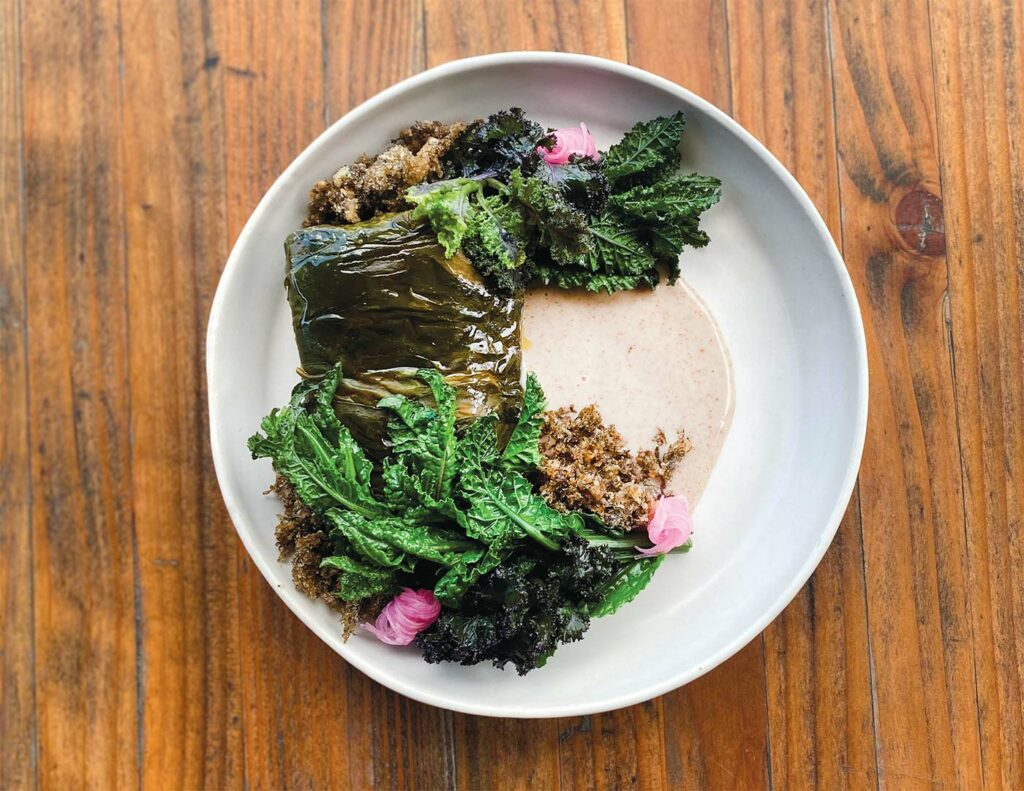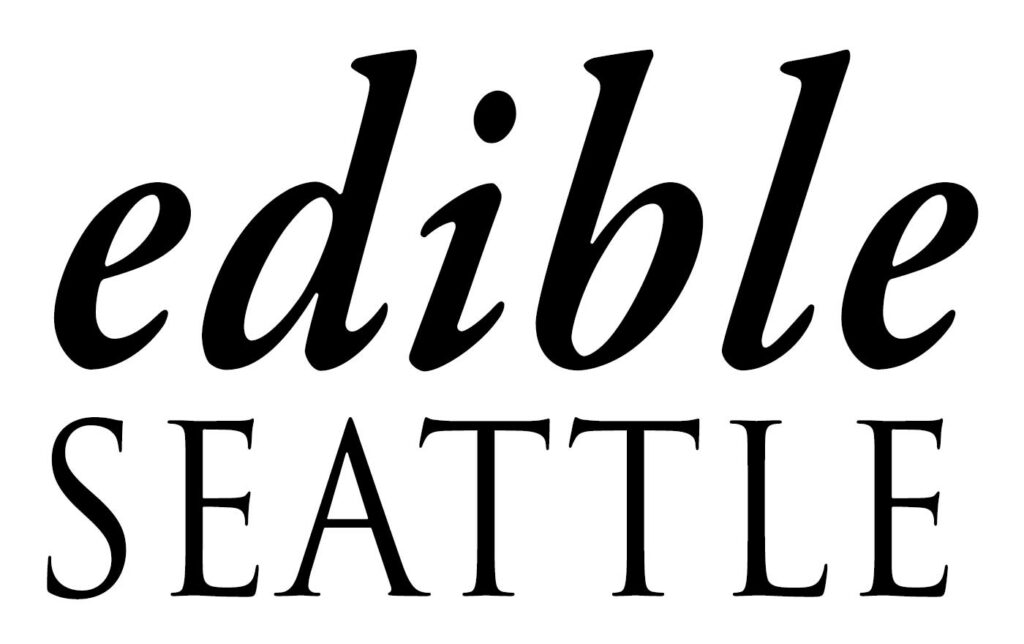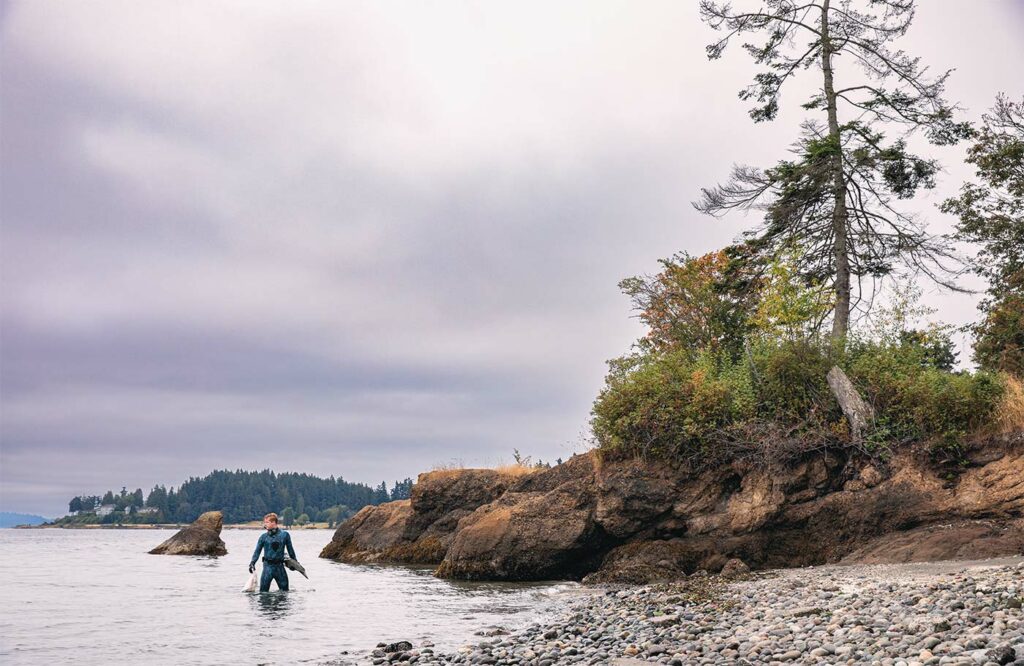
Two Washington chefs get creative with seaweed
Grant Rico is holding the sea in his hands.
He just plucked a spindly cluster of red sea spaghetti from a tide pool filled with tiny crabs, limpets and barnacles on Bainbridge Island’s Rockaway Beach. These basins of weathered rock are so prominent here that, from a distance, you might think King Triton set up a giant salad bowl on a table across the sea. The salad is filled with things like the slightly metallic-tasting sea spaghetti, which looks like strands of red licorice; elegant and silken sea lettuce, which looks like field greens, and has a subtly vegetal taste; the Dr. Seuss-ian looking bladderwrack, its yellow bobbly tops and slippery leathery tails tasting like salted butter; and the burgundy-hued dulse, which looks and tastes a bit like bacon.
Rico piles handfuls of each variety into Tupperware containers—“in Washington, you can harvest up to 10 pounds of seaweed per person with a fishing license,” he says—and brings it to his car, along with two giant buckets of sea water he’ll later turn into salt.
Back in his kitchen workshop—which, at the time, was Seabird, where he was executive chef—he rinses the seaweed and pulls out a few tiny worms and baby snails. “Look at these little guys,” he laughs, dropping them into a small bowl of sea water he’ll release into the Puget Sound later. “Cleaning seaweed is so much easier than a lot of other products we deal with as chefs. Cleaning asparagus and mushrooms is much harder.”
He organizes the seaweed into piles on the counter to dry, and suddenly I understand how the ecosystem works. Parts of the sea are drying here on the land, alongside the hum of the refrigerators. The trees outside sway in the wind, and though I tasted the salt air earlier, being indoors erases it from my memory. Removed from nature, I forget where I am, and Rico’s goal is to help me remember.
“There’s an old saying, ‘what grows together goes together.’ My goal is to allow nature to be represented in a time and place that we’re in, and it’s impossible to do that anywhere near the Puget Sound without having seaweed involved.” —Chef Grant Rico
A SENSE OF PLACE
His dish of Dungeness crab with puffed wild rice looked like pebbles on a beach and tasted like briny pop rocks. Silky kelp ribbons mingled with bits of crab peeking from beneath a layer of sea foam-like froth from a rich crab butter broth. It tasted as if a parade of tiny crabs from a Disney musical marched straight from the sea into my mouth.
Another dish of sugar kelp-wrapped King salmon topped with crispy dulse, resting atop a cream made of madrone bark and fish fumet, was rich and subtly briny with notes of bitter tannins and maple syrup. It was unexpected and superb.
The opposite of a flashy chef begging for fame, Rico approaches his work with a quiet sense of pride when he could be shouting from the rooftops that, during his tenure at Seabird, the restaurant was #12 on Esquire magazine’s Best New Restaurants in America 2022 list, and on Bon Appetit’s 24 Best New Restaurants of 2023 list.
“At least once a week, someone would tell me this was the best meal of their life,” he recalls. “That’s why I do what I do. I’m not a chef just because I like to cook. I like creating experiences that are above and beyond memorable for people.”
Part of that memory comes from eating food that offers a sense of place. And what better way to cement such a sensory experience than through something as bountiful as seaweed, which is plentiful in waterways and on beaches throughout the state.
“There’s an old saying, ‘what grows together goes together,’” he says. “My goal is to allow nature to be represented in a time and place that we’re in, and it’s impossible to do that anywhere near the Puget Sound without having seaweed involved.”
BRINGING THE TIDE TO THE TABLE
Rico—who grew up on Hood Canal—remembers getting tangled in clusters of seaweed as a kid, and returning to shore to throw it at his friends, but he certainly wouldn’t have guessed how prominently it would one day play in his life. After attending the Culinary Institute of America in Hyde Park, New York, he worked for a variety of restaurants across the country before landing at three Michelin-starred SingleThread in Healdsburg, California, where he served as chef de partie. He’d accompany another chef to Sonoma on weekends for spear fishing and seaweed harvesting excursions, where they’d use what they found on the menu. He reflected that while seaweed is a vital component of Asian cuisines, it has yet to take the same hold on American fine dining.
“Maybe there are [American fine dining] chefs doing what I do and not mentioning seaweed,” he says, “but as far as I can tell, only a handful of restaurants in this country are highlighting seaweed on their menus.”
That reality fuels his advocacy work even more, so that now, when he picks up a blade of seaweed, he uses it as a teaching moment on his menus and in his recipes, helping people understand the value of what they’re holding in their hands.
“Though native cultures have always been using seaweed, as an industry, seaweed is in its nascency in the U.S. Up until the last few years, seaweed farmers didn’t have markets to sell into because there weren’t companies to buy their product and use it at the scale everyone wanted to see.” —Chef Travis Bettinson
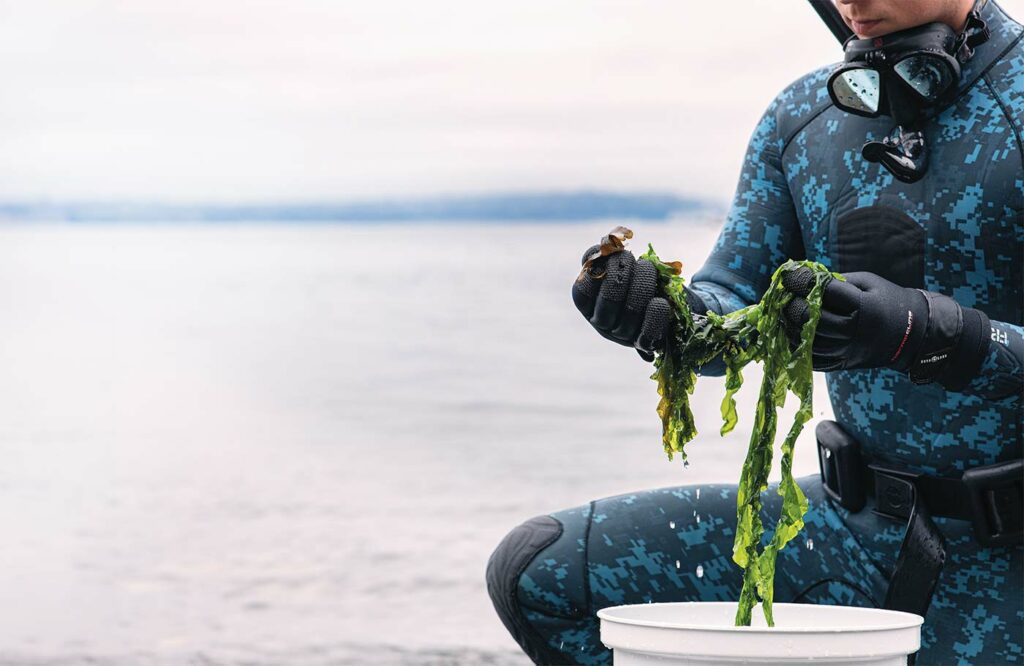
A CHAMPION FOR KELP
Travis Bettinson does exactly the same when I go with him to visit Blue Dot Sea Farms, the farm partner to his Blue Dot Kitchen. The five-acre kelp and shellfish farm on Hood Canal was one of Washington’s first commercially licensed kelp farms. We take a small boat a few miles into the canal, then park to watch the farmers slice through kelp they pulled in on a conveyor belt and into tubs. The crew tosses some kelp onto our boat, and we pose for pictures. I take videos full of seagulls in flight, mountains of kelp and the ripple of the boat’s wake, but the only background noise comes from Bettinson, waxing poetic about how miraculous this plant really is.
“Seaweed is a powerful tool, as it absorbs multitudes more carbon dioxide than land-based plants do,” he says. “It takes the extra carbon dioxide that ocean systems absorb from the atmosphere and in doing so combats ocean acidification, which is preventing marine organisms in the Puget Sound from forming healthy skeletons and shells. It’s an amazing resource to be using in the future for all different industries.
“Though native cultures have always been using seaweed, as an industry, seaweed is in its nascency in the U.S. Up until the last few years, seaweed farmers didn’t have markets to sell into because there weren’t companies to buy their product and use it at the scale everyone wanted to see.”
Bettinson, who earned a bachelor’s in culinary arts and nutrition from Johnson and Wales, and a master’s in food science and management from Washington State University, was operating a catering and private chef service when he realized he wanted to make an impact in the world.
“The two women who do the Gastropod podcast did a piece on kelp farming, and I fell in love with it,” he recalls. “I made contact with Blue Dot [Sea Farms] and we had the same thoughts about building markets for the actual crop. We were able to found Blue Dot Kitchen together.”

MAKING IT MAINSTREAM
Bettinson wanted to create an impactful product you could find in the mainstream aisle of a grocery store, which is how he ended up developing Seacharrones, a light and airy kelp puff made to taste like a sinful snack but is vegan and gluten-free.
You find Seacharrones in places like PCC Community Markets and Cooka T’s concession stand at Lumen Field, but now you can find it in an incredibly mainstream product: beer.
“In our effort to build a culture around kelp in the PNW, we have partnered with some of the best local producers who’ll make amazing products that pair perfectly with Seacharrones,” he says. “Most notably, we partnered with Fair Isle Brewing to make ‘Salacia,’ a kelp saison that will launch this spring.”
While Bettinson is focusing on beer and Seacharrones for now, he’s happy that Rico made so many creative dishes using Blue Dot’s kelp during his tenure at Seabird, and is excited that other chefs are joining the club, like chef Elizabeth Kenyon at Rupee Bar in Ballard. He’s hopeful that more restaurant accounts will be on the horizon.
And though Rico has been busy consulting and doing R&D for new restaurant concepts across the country, offering pop-ups and private dinners, you can bet he’ll join that list when he opens his own restaurant.
“I love supporting fellow chefs like Travis, as what he’s offering can’t be found on shore, and really enhances my work in the kitchen,” he says. “I also love harvesting my own seaweed. Chefs don’t always have time and I get that, but it’s pretty easy compared to all the things we do as chefs. And you get to hang out at the beach.”
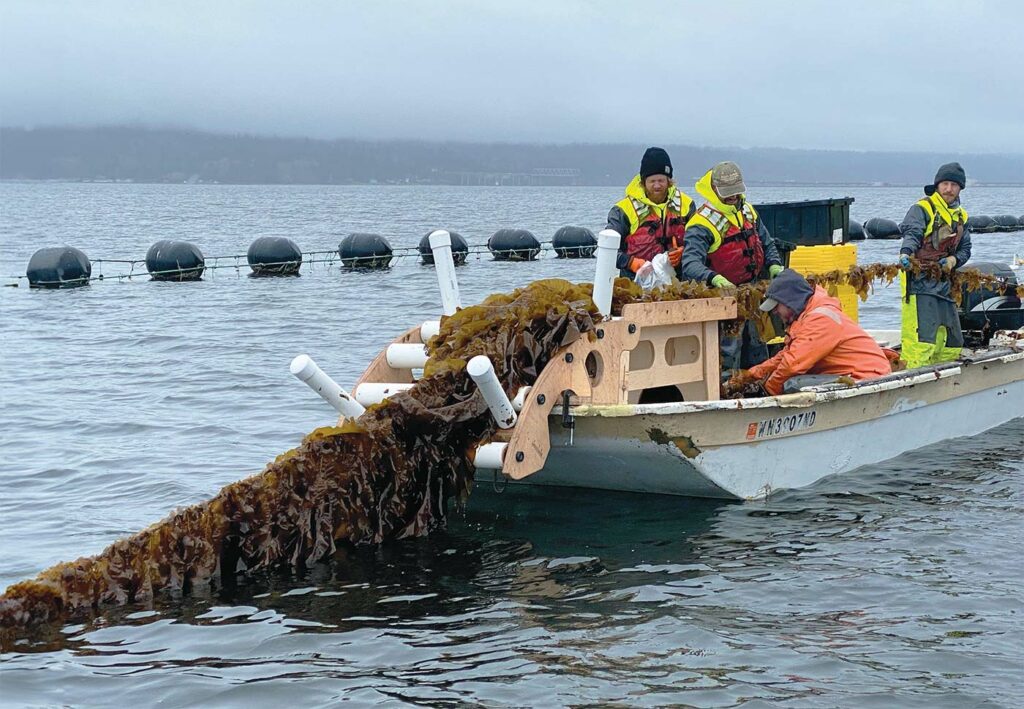
KNOW BEFORE YOU GO!
If you want to try your hand at foraging for your own seaweeds, here are some guidelines to follow:
You need a license to harvest seaweed in Washington State. You can visit the WA Dept of Fish & Wildlife or sport fishing stores to get a permit. Additional limits are listed.
Use bit.ly/seaweedharvest and dnr.wa.gov/seaweed as starting points.
Know the regulations in the area. When? How? How much? In WA you can harvest up to 10 pounds of seaweed (wet) each day with a permit, but only certain kinds. The state also keeps track of hazardous areas restricted from harvesting, and designated public lands and ocean areas. Check before you hit the beach.
Harvest seaweed outside the growing area so the plant can continue to photosynthesize, and research what can and can’t be foraged. There are restrictions on harvesting bull whip kelp, for example. For all seaweeds, be sure to leave the holdfast (root structure) of the plant, and use a knife or scissors to cut, never tear the plants.
Like land foraging, spread your harvest out. This will lessen your impact on specific ecosystems, and leave enough plants for the organisms that also need them for food and shelter. Be aware of your step also, tidelands are teeming with life. Be a good steward!
Consume seaweed only from clean harvesting sites! Avoid industrial areas, run-off zones and areas used for shell fishing. Choose clean and open coastlines.
Consider taking a class with knowledgeable guides. The best way to learn is from an expert.
Finally, be respectful of traditional First Nations lands, waters and resources.

